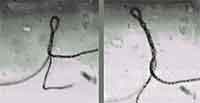Mutant Ninja?
 a strain of bacteria has won devotees among mathematicians, engineers and physists due to its several applications. A mutant form of a common, rod-shaped bacterium, Bacillus subtilis was discovered in 1975 by Neil Mendelson, a microbiologist of University of Arizona, usa. Today, it is being used by scientists to develop theory and application in areas ranging from solar physics to material science ( Science , Vol 276, No 5318).
a strain of bacteria has won devotees among mathematicians, engineers and physists due to its several applications. A mutant form of a common, rod-shaped bacterium, Bacillus subtilis was discovered in 1975 by Neil Mendelson, a microbiologist of University of Arizona, usa. Today, it is being used by scientists to develop theory and application in areas ranging from solar physics to material science ( Science , Vol 276, No 5318).
The bacterium, which is about four micrometres long and 0.7 micrometre in diameter, has a strain that lacks certain enzymes required to separate the daughter cells after the cell division. Interestingly, the individual filaments of the linked cells spontaneously twist and form a thick, spiral coil which Mendelson has termed macrofibres.
Mathematicians are using this spontaneous movement into the third dimension, to study and understand flexible elastic filaments.Though they have been studying the twisting of these elastic filaments for a long time, most of their models have been static. With the bacterial strain, they have found a living laboratory which has proved to be of immense use.
Michael Tabor and his colleagues at the University of Arizona, have studied colonies of the bacterium for many years and developed new dynamic equations to describe the twisting and coiling of macrofibres. The spontaneous movement of the filaments into the third dimension gives rise to the twist and coil, termed 'writhe'. These mathe-maticians have found that changing some of the parameters in the equations give rise to mathematical instabilities which causes the shift into the third dimension.
The new model of elastic filaments has already found use in many diverse areas ranging from the coiling of dna to the solar magnetic field. It has been applied to describe the solar magnetic flux tubes by Dana Longscope and Isaac Klapper. Magnetic flux tubes are bundles of magnetic force lines which come from the solar interior and float to the surface as sunspots. The tails of these tubes, which go back into the interior, can be modelled as elastic filaments. Longscope and Klapper find that the flux tubes release their energy when they writhe out of the plane and this energy is released as solar flares.
Recently, Mendelson and his colla-borators have developed bionites with silicon which may be very useful as biological implants. Ordinary silica is usually used for implants because it is inert (it does not react with biological tissue) and stable. But it contains very small pores (typically, one-billionth of a metre in width) which means that natural tissue cannot attach to it. Bionite, on the other hand, has natural pores which are small but also has larger channels about 0.5 micrometre (one-millionth of a metre) in diameter. These can then provide a framework for cell growth as well as allowing useful chemicals like antibiotics to move through.
With more development, the bacterium could prove to be the wonder biological material and find widespread use. When Mendelson discovered the unusual strain of Bacillus subtilis , he could not have imagined the variety of uses it would be put to or that it would find its way into standard microbiology textbooks.
